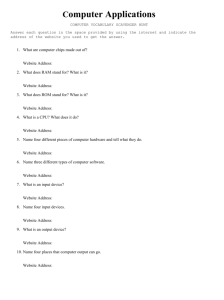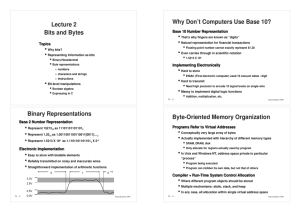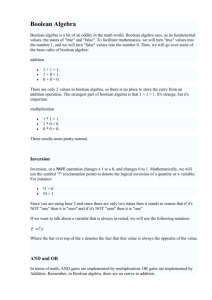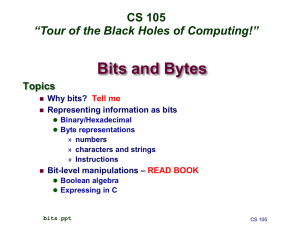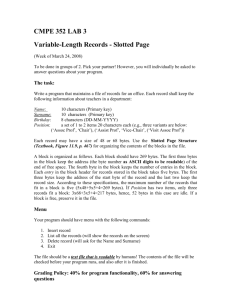Bits and Bytes
advertisement
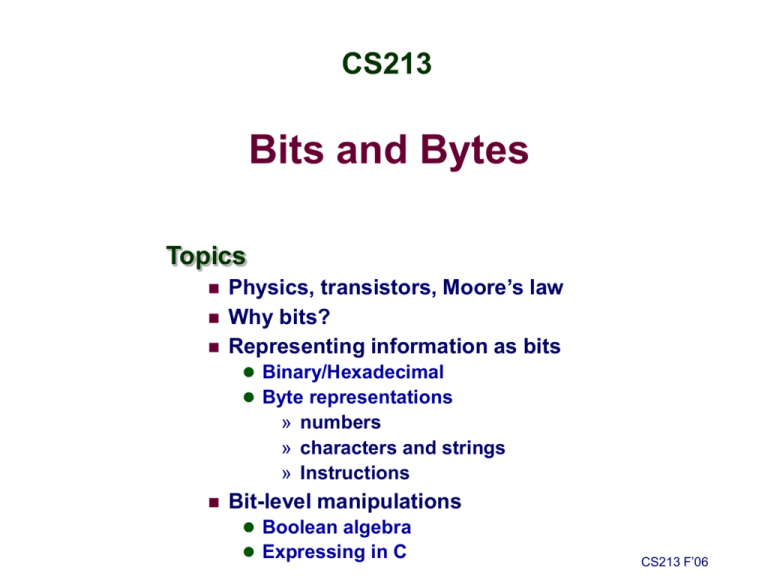
CS213
Bits and Bytes
Topics
Physics, transistors, Moore’s law
Why bits?
Representing information as bits
Binary/Hexadecimal
Byte representations
» numbers
» characters and strings
» Instructions
Bit-level manipulations
Boolean algebra
Expressing in C
CS213 F’06
The Machine of the System Architecture
Instruction Set
Architecture
Microarchitecture
Microprocessors Memory Systems
Buses
Disk Systems NICs, …
Memory Combinational Logic
Transistors
Semiconductors and
photolithography
Classical Physics
Chemistry
Quantum Physics
–2–
CS213, F’06
Transistors
Processor and memory are
constructed from
semiconductors
Metal Oxide Semiconductor
Field Effect Transistor
Transistor is the key building
block
MOSFET
–3–
CS213, F’06
Logic and Memory
Using transistors, we can create combinatorial logic
E.g., NAND
Using transistors and capacitors, we can create memory (see the
handout)
DRAM (main memory) uses capacitors and
SRAM (L1 and L2 caches) uses transistors
much faster and much more expensive!
–4–
CS213, F’06
Chips
Bird’s eye of
the Intel
Pentium 4
chip
Moore’s Law:
Every 18 months, the number of transistors would
double
–5–
CS213, F’06
Why Don’t Computers Use Base 10?
Base 10 Number Representation
That’s why fingers are known as “digits”
Natural representation for financial transactions
Floating point number cannot exactly represent $1.20
Even carries through in scientific notation
1.5213 X 104
Implementing Electronically
Hard to store
ENIAC (First electronic computer) used 10 vacuum tubes / digit
Hard to transmit
Need high precision to encode 10 signal levels on single wire
Messy to implement digital logic functions
Addition, multiplication, etc.
–6–
CS213, F’06
Binary Representations
Base 2 Number Representation
Represent 1521310 as 111011011011012
Represent 1.2010 as 1.0011001100110011[0011]…2
Represent 1.5213 X 104 as 1.11011011011012 X 213
Electronic Implementation
Easy to store with bistable elements
Reliably transmitted on noisy and inaccurate wires
0
1
0
3.3V
2.8V
0.5V
0.0V
–7–
Straightforward implementation of arithmetic functions
CS213, F’06
How Do We Represent the Address
Space?
Hexadecimal Notation
Byte = 8 bits
Binary 000000002
Decimal:
010
Hexadecimal
0016
to
to
to
111111112
25510
FF16
Base 16 number representation
Use characters ‘0’ to ‘9’ and ‘A’ to ‘F’
Write FA1D37B16 in C as 0xFA1D37B
» Or 0xfa1d37b
–8–
0
1
2
3
4
5
6
7
8
9
A
B
C
D
E
F
0
1
2
3
4
5
6
7
8
9
10
11
12
13
14
15
0000
0001
0010
0011
0100
0101
0110
0111
1000
1001
1010
1011
1100
1101
1110
1111
CS213, F’06
Machine Words
Machine Has “Word Size”
Nominal size of integer-valued data
Including addresses
A virtual address is encoded by such a word
Most current machines are 32 bits (4 bytes)
Limits addresses to 4GB
Becoming too small for memory-intensive applications
High-end systems are 64 bits (8 bytes)
Potentially address 1.8 X 1019 bytes
Machines support multiple data formats
Fractions or multiples of word size
Always integral number of bytes
–9–
CS213, F’06
Word-Oriented Memory
Organization
32-bit 64-bit
Words Words
Addresses Specify Byte
Locations
Address of first byte in
word
Addresses of successive
words differ by 4 (32-bit) or
8 (64-bit)
Addr
=
0000
??
Addr
=
0000
??
Addr
=
0004
??
Addr
=
0008
??
Addr
=
0012
??
– 10 –
Addr
=
0008
??
Bytes Addr.
0000
0001
0002
0003
0004
0005
0006
0007
0008
0009
0010
0011
0012
0013
0014
0015
CS213, F’06
Data Representations
Sizes of C Objects (in Bytes)
C Data Type Compaq Alpha
Typical 32-bit
Intel IA32
int
4
4
4
long int
8
4
4
char
1
1
1
short
2
2
2
float
4
4
4
double
8
8
8
long double
8
8
10/12
char *
8
4
4
» Or any other pointer
Portability:
» Many programmers assume that object declared as int can
be used to store a pointer
• True for a typical 32-bit machine
• Not for Alpha
– 11 –
CS213, F’06
Byte Ordering
How should bytes within multi-byte word be ordered in
memory?
Conventions
Sun’s, Mac’s are “Big Endian” machines
Least significant byte has highest address (comes last)
Alphas, PC’s are “Little Endian” machines
Least significant byte has lowest address (comes first)
– 12 –
CS213, F’06
Byte Ordering Example
Big Endian
Least significant byte has highest address
Little Endian
Least significant byte has lowest address
Example
Variable x has 4-byte representation 0x01234567
Address given by &x is 0x100
Big Endian
0x100 0x101 0x102 0x103
01
Little Endian
45
67
0x100 0x101 0x102 0x103
67
– 13 –
23
45
23
01
CS213, F’06
Reading Byte-Reversed Listings
For most application programmers, these issues are invisible (e.g.,
networking)
Disassembly
Text representation of binary machine code
Generated by program that reads the machine code
Example Fragment
Address
Instruction Code
8048365:
5b
8048366:
81 c3 ab 12 00 00
804836c:
83 bb 28 00 00 00 00
Assembly Rendition
pop
%ebx
add
$0x12ab,%ebx
cmpl
$0x0,0x28(%ebx)
Deciphering Numbers
– 14 –
Value:
Pad to 4 bytes:
Split into bytes:
Reverse:
0x12ab
0x000012ab
00 00 12 ab
ab 12 00 00
CS213, F’06
Examining Data Representations
Code to Print Byte Representation of Data
Casting pointer to unsigned char * creates byte array
typedef unsigned char *pointer;
void show_bytes(pointer start, int len)
{
int i;
for (i = 0; i < len; i++)
printf("0x%p\t0x%.2x\n",
start+i, start[i]);
printf("\n");
}
Printf directives:
%p: Print pointer
%x: Print Hexadecimal
– 15 –
CS213, F’06
show_bytes Execution Example
int a = 15213;
printf("int a = 15213;\n");
show_bytes((pointer) &a, sizeof(int));
Result (Linux):
int a = 15213;
– 16 –
0x11ffffcb8
0x6d
0x11ffffcb9
0x3b
0x11ffffcba
0x00
0x11ffffcbb
0x00
CS213, F’06
Representing Strings
Strings in C
char S[6] = "15213";
Represented by array of characters
Each character encoded in ASCII format
Standard 7-bit encoding of character set
Other encodings exist, but uncommon
Character “0” has code 0x30
» Digit i has code 0x30+i
String should be null-terminated
Final character = 0
Linux/Alpha S Sun S
31
35
32
31
33
00
31
35
32
31
33
00
Compatibility
Byte ordering not an issue
Data are single byte quantities
Text files generally platform independent
Except for different conventions of line termination character(s)!
– 17 –
CS213, F’06
Machine-Level Code Representation
Encode Program as Sequence of Instructions
Each simple operation
Arithmetic operation
Read or write memory
Conditional branch
Instructions encoded as bytes
Alpha’s, Sun’s, Mac’s use 4 byte instructions
» Reduced Instruction Set Computer (RISC)
PC’s use variable length instructions
» Complex Instruction Set Computer (CISC)
Different instruction types and encodings for different
machines
Most code not binary compatible
A Fundamental Concept:
Programs are Byte Sequences Too!
– 18 –
CS213, F’06
Representing Instructions
int sum(int x, int y)
{
return x+y;
}
For this example, Alpha &
Sun use two 4-byte
instructions
Use differing numbers of
instructions in other cases
PC uses 7 instructions with
lengths 1, 2, and 3 bytes
Same for NT and for Linux
NT / Linux not fully binary
compatible
Alpha sum
00
00
30
42
01
80
FA
6B
Sun sum
PC sum
81
C3
E0
08
90
02
00
09
55
89
E5
8B
45
0C
03
45
08
89
EC
5D
C3
Different machines use totally different instructions and encodings
– 19 –
CS213, F’06
Boolean Algebra
Developed by George Boole in 19th Century
Algebraic representation of logic
Encode “True” as 1 and “False” as 0
And
Not
Or
A&B = 1 when both A=1 and
B=1
& 0 1
0 0 0
1 0 1
~A = 1 when A=0
~
0 1
1 0
– 20 –
A|B = 1 when either A=1 or
B=1
| 0 1
0 0 1
1 1 1
Exclusive-Or (Xor)
A^B = 1 when either A=1 or
B=1, but not both
^ 0 1
0 0 1
1 1 0
CS213, F’06
Application of Boolean Algebra
Applied to Digital Systems by Claude Shannon
1937 MIT Master’s Thesis
Reason about networks of relay switches
Encode closed switch as 1, open switch as 0
A&~B
A
Connection when
~B
A&~B | ~A&B
~A
B
~A&B
– 21 –
= A^B
CS213, F’06
Integer Algebra
Integer Arithmetic
– 22 –
Z, +, *, –, 0, 1 forms a mathematical structure called “ring”
Addition is “sum” operation
Multiplication is “product” operation
– is additive inverse
0 is identity for sum
1 is identity for product
CS213, F’06
Boolean Algebra
Boolean Algebra
– 23 –
{0,1}, |, &, ~, 0, 1 forms a mathematical structure called
“Boolean algebra”
Or is “sum” operation
And is “product” operation
~ is “complement” operation (not additive inverse)
0 is identity for sum
1 is identity for product
CS213, F’06
Boolean Algebra Integer Ring
Commutativity
A|B = B|A
A&B = B&A
Associativity
(A | B) | C = A | (B | C)
(A & B) & C = A & (B & C)
Product distributes over sum
A & (B | C) = (A & B) | (A & C)
Sum and product identities
A|0 = A
A&1 = A
Zero is product annihilator
A&0 = 0
Cancellation of negation
~ (~ A) = A
– 24 –
A+B = B+A
A*B = B*A
(A + B) + C = A + (B + C)
(A * B) * C = A * (B * C)
A * (B + C) = A * B + B * C
A+0 = A
A*1 =A
A*0 = 0
– (– A) = A
CS213, F’06
Boolean Algebra Integer Ring
Boolean: Sum distributes over product
A | (B & C) = (A | B) & (A | C) A + (B * C) (A + B) * (B + C)
Boolean: Idempotency
A|A = A
A +AA
“A is true” or “A is true” = “A is true”
A&A = A
Boolean: Absorption
A | (A & B) = A
A *AA
A + (A * B) A
“A is true” or “A is true and B is true” = “A is true”
A & (A | B) = A
Boolean: Laws of Complements
A | ~A = 1
A * (A + B) A
A + –A 1
“A is true” or “A is false”
Ring: Every element has additive inverse
A | ~A 0
A + –A = 0
– 25 –
CS213, F’06
Boolean Ring
Properties of & and ^
{0,1}, ^, &, , 0, 1
Identical to integers mod 2
is identity operation: (A) = A
A^A=0
Property
– 26 –
Commutative sum
Commutative product
Associative sum
Associative product
Prod. over sum
0 is sum identity
1 is prod. identity
0 is product annihilator
Additive inverse
Boolean Ring
A^B = B^A
A&B = B&A
(A ^ B) ^ C = A ^ (B ^ C)
(A & B) & C = A & (B & C)
A & (B ^ C) = (A & B) ^ (B & C)
A^0 = A
A&1 = A
A&0=0
A^A = 0
CS213, F’06
Relations Between Operations
DeMorgan’s Laws
Express & in terms of |, and vice-versa
A & B = ~(~A | ~B)
» A and B are true if and only if neither A nor B is false
A | B = ~(~A & ~B)
» A or B are true if and only if A and B are not both false
Exclusive-Or using Inclusive Or
A ^ B = (~A & B) | (A & ~B)
» Exactly one of A and B is true
A ^ B = (A | B) & ~(A & B)
» Either A is true, or B is true, but not both
– 27 –
CS213, F’06
General Boolean Algebras
We can extend the four Boolean operations to also operate on bit
vectors
Operations applied bitwise
01101001
& 01010101
01000001
01000001
01101001
| 01010101
01111101
01111101
01101001
^ 01010101
00111100
00111100
~ 01010101
10101010
10101010
All of the Properties of Boolean Algebra Apply
Resulting algebras:
Boolean algebra: {0,1}(w), |, &, ~, 0(w), 1(w)
Ring: {0,1}(w), ^, &, , 0(w), 1(w)
– 28 –
CS213, F’06
Representing & Manipulating Sets
One useful application of bit vectors is to represent finite sets
Representation
Width w bit vector represents subsets of {0, …, w–1}
aj = 1 if j A
01101001
{ 0, 3, 5, 6 }
76543210
01010101
76543210
{ 0, 2, 4, 6 }
Operations
&
Intersection
01000001
{ 0, 6 }
|
^
~
Union
Symmetric difference
Complement
01111101
00111100
10101010
{ 0, 2, 3, 4, 5, 6 }
{ 2, 3, 4, 5 }
{ 1, 3, 5, 7 }
– 29 –
CS213, F’06
Bit-Level Operations in C
Operations &, |, ~, ^ Available in C
Apply to any “integral” data type
long, int, short, char
View arguments as bit vectors
Arguments applied bit-wise
Examples (Char data type)
~0x41 -->
0xBE
~010000012
~0x00 -->
--> 101111102
0xFF
~000000002
0x69 & 0x55
--> 111111112
-->
0x41
011010012 & 010101012 --> 010000012
0x69 | 0x55
-->
0x7D
011010012 | 010101012 --> 011111012
– 30 –
CS213, F’06
Contrast: Logic Operations in C
Contrast to Logical Operators
&&, ||, !
View 0 as “False”
Anything nonzero as “True”
Always return 0 or 1
Early termination
Examples (char data type)
!0x41 -->
!0x00 -->
!!0x41 -->
0x69 && 0x55
-->
0x01
0x69 || 0x55
-->
0x01
– 31 –
0x00
0x01
0x01
CS213, F’06
Shift Operations
Left Shift:
x << y
Shift bit-vector x left y positions
Throw away extra bits on left
Fill with 0’s on right
Right Shift:
x >> y
Shift bit-vector x right y
positions
Throw away extra bits on right
Logical shift
Fill with 0’s on left
Arithmetic shift
Argument x 01100010
<< 3
00010000
Log. >> 2
00011000
Arith. >> 2 00011000
Argument x 10100010
<< 3
00010000
Log. >> 2
00101000
Arith. >> 2 11101000
Replicate most significant bit on
– 32 –
right
Useful with two’s complement
integer representation
CS213, F’06
Main Points
It’s All About Bits & Bytes
Numbers
Programs
Text
Different Machines Follow Different Conventions
Word size
Byte ordering
Representations
Boolean Algebra is Mathematical Basis
Basic form encodes “false” as 0, “true” as 1
General form like bit-level operations in C
Good for representing & manipulating sets
– 33 –
CS213, F’06
Backup Slides
Byte-Oriented Memory Organization
Programs Refer to Virtual Addresses
Conceptually very large array of bytes
Actually implemented with hierarchy of different memory
types
SRAM, DRAM, disk
Only allocate for regions actually used by program
In Unix and Windows NT, address space private to particular
“process”
Program being executed
Program can manipulate its own data, but not that of others
Compiler + Run-Time System Control Allocation
– 35 –
Where different program objects should be stored
Multiple mechanisms: static, stack, and heap
In any case, all allocation within single virtual address space
CS213, F’06


